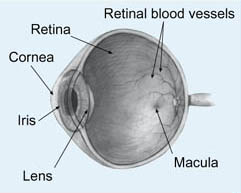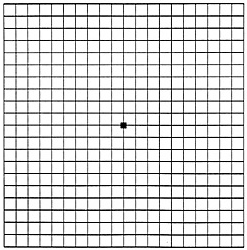What is age-related macular degeneration (AMD)?
AMD is a common eye disease associated with aging that gradually destroys sharp, central vision. Central vision is needed for seeing objects clearly and for common daily tasks such as reading and driving. In some people, AMD advances so slowly that it will have little effect on their vision as they age. But in others, the disease progresses faster and may lead to a loss of vision in one or both eyes.
How does AMD damage vision?
The retina is a paper-thin tissue that lines the back of the eye and sends visual signals to the brain. In the middle of the retina is a tiny area called the macula. The macula is made up of millions of light-sensing cells that help to produce central vision.
AMD occurs in two forms:
- Dry AMD–Ninety percent of all people with AMD have this type. Scientists are still not sure what causes dry AMD. Studies suggest that an area of the retina becomes diseased, leading to the slow breakdown of the light-sensing cells in the macula and a gradual loss of central vision.
- Wet AMD–Although only 10 percent of all people with AMD have this type, it accounts for 90 percent of all blindness from the disease. As dry AMD worsens, new blood vessels may begin to grow and cause “wet” AMD. Because these new blood vessels tend to be very fragile, they will often leak blood and fluid under the macula. This causes rapid damage to the macula that can lead to the loss of central vision in a short period of time.
Who is most likely to get AMD?
The greatest risk factor is age. Although AMD may occur during middle age, studies show that people over age 60 are clearly at greater risk than other age groups. For instance, a large study found that people in middle-age have about a 2 percent risk of getting AMD, but this risk increased to nearly 30 percent in those over age 75.

Other AMD risk factors include:
- Gender–Women tend to be at greater risk for AMD than men.
- Race–Whites are much more likely to lose vision from AMD than Blacks.
- Smoking–Smoking may increase the risk of AMD.
- Family History–Those with immediate family members who have AMD are at a higher risk of developing the disease.
What are the symptoms?
Both dry and wet AMD cause no pain. The most common early sign of dry AMD is blurred vision. As fewer cells in the macula are able to function, people will see details less clearly in front of them, such as faces or words in a book. Often this blurred vision will go away in brighter light. If the loss of these light–sensing cells becomes great, people may see a small–but growing-blind spot in the middle of their field of vision.
The classic early symptom of wet AMD is that straight lines appear crooked. This results when fluid from the leaking blood vessels gathers and lifts the macula, distorting vision. A small blind spot may also appear in wet AMD, resulting in loss of one’s central vision.


How is it detected?
Your eye care professional may suspect AMD if you are over age 60 and have had recent changes in your central vision. To look for signs of the disease, he or she will use eye drops to dilate, or enlarge, your pupils. Dilating the pupils allows your eye care professional to view the back of the eye better.
You may also be asked to view an Amsler grid, a pattern that looks like a checkerboard. Early changes in your central vision will cause the grid to appear distorted, a sign of AMD.
How can it be treated?
No treatment now exists for dry AMD. It has been suggested that taking certain extra vitamins and minerals may slow the progress of the disease. But this treatment needs much more research before scientists can know for sure if it’s helpful.
How is AMD detected?
Eye care professionals detect AMD during an eye examination that includes:
Visual acuity test: This eye chart test measures how well you see at various distances.
Pupil dilation: This examination enables your eye care professional to see more of the retina and look for signs of AMD. To do this, drops are placed into the eye to dilate (widen) the pupil. After the examination, your vision may remain blurred for several hours.
One of the most common early signs of AMD is the presence of drusen. Drusen are tiny yellow deposits in the retina. Your eye care professional can see them during an eye examination. The presence of drusen alone does not indicate a disease, but it might mean that the eye is at risk for developing more severe AMD.
While conducting the examination, your eye care professional may ask you to look at an Amsler grid. This grid is a pattern that resembles a checkerboard. You will be asked to cover one eye and stare at a black dot in the center of the grid. While staring at the dot, you may notice that the straight lines in the pattern appear wavy to you. You may notice that some of the lines are missing. These may be signs of wet AMD (See Amsler Grid below.)
If your eye care professional suspects you have wet AMD, you may need to have a test called fluorescein angiography. In this test, a special dye is injected into a vein in your arm. Pictures are then taken as the dye passes through the blood vessels in the retina. The photos help your eye care professional evaluate leaking blood vessels to determine whether they can be treated.

Do NOT depend on this grid for any diagnoses.
While covering one eye, look at dot in center of grid. If lines around dot are wavy or distorted, you should see your eye care professional.

On the top grid picture is what an Amsler grid normally looks like, and the illustration second picture just above this paragraph is how it might look to someone with AMD. These grids are reduced in size; ask your doctor for a full-size grid to use at home.
Eye care professionals can treat some cases of wet AMD with laser surgery. This treatment involves aiming a strong light beam onto the new blood vessels to destroy them. Laser surgery is done in a doctor’s office or in an eye clinic and lasts a short period of time. Although a person may go home the same day, he or she will need to return for follow-up exams.
How is AMD treated?
Dry AMD currently cannot be treated. But this does not mean that you will lose your sight. Fortunately, dry AMD develops very slowly. You may lose some of your central vision over the years. However, most people are able to lead normal, active lives–especially if AMD affects only one eye.
Some cases of wet AMD can be treated with laser surgery. The treatment involves aiming a high energy beam of light directly onto the leaking blood vessels. Laser treatment is more effective if the leaky blood vessels have developed away from the fovea–the central part of the macula. But even if the blood vessels are growing right behind the fovea, the treatment can be of some value in stopping further vision loss.
How is laser surgery preformed?
Laser surgery is performed in your eye care professional’s office or eye clinic. Before the surgery, he or she will: (1) dilate your pupil and (2) apply drops to numb the eye. In some cases, he or she also may numb the area behind the eye to prevent any discomfort.
The lights in the office will be dim. As you sit facing the laser machine, your eye care professional will hold a special lens to your eye. You may see flashes of light.
You can leave the office once the treatment is done, but you will need someone to drive you home. Because your pupils will stay dilated for a few hours, you also should bring a pair of sunglasses.
For the rest of the day, your vision may be a little blurry. Your eye may also hurt a bit. This is easily controlled with drugs that your eye care professional can suggest.
You will need to make frequent follow-up visits. During each exam, you may have fluorescein angiography to make sure that the blood vessels are not still leaking, or that new blood vessels have not developed. If the vessels continue to leak, you might need some more laser surgery. It is important to realize that laser surgery is not a cure for AMD. It is only a treatment to help stop further vision loss. The risk of new blood vessels growing back after laser treatment is relatively high.
What research is being done?
The National Eye Institute (NEI) is the Federal government’s lead agency for vision research. The NEI is supporting a number of research studies both in the laboratory and with patients to learn more about the cause of AMD. This research should provide better ways to detect, treat, and prevent vision loss in people with the disease.
Findings from the NEI-sponsored Age-Related Eye Disease Study (AREDS) showed that high levels of antioxidants and zinc significantly reduces the risk of advanced age- related macular degeneration (AMD) by about 25 percent.
Scientists have begun to study the possibility of transplanting healthy cells into a diseased retina. Although this work is at a very early stage and still experimental, someday it may help people keep their vision or restore some lost vision.
What can you do to protect your vision?
Dry AMD. If you have dry AMD, you should have your eyes examined through dilated pupils at least once a year. This will allow your eye care professional to monitor your condition and check for other eye diseases as well.
You should also obtain an Amsler grid from an eye care professional to use at home. This will provide you with a quick and inexpensive test to evaluate your vision each day for signs of wet AMD. It works best for people who still have good central vision. You should check each eye separately–cover one eye and look at the grid, then cover your other eye and look at the grid. You also may want to check your vision by reading the newspaper, watching television, and just looking at people’s faces. If you detect any changes, you should have an eye exam.
Wet AMD. If you have wet AMD, it is important not to delay laser surgery if your eye care professional advises you to have it. After surgery, you will need to have frequent eye examinations to detect any recurrence of leaking blood vessels. Studies show that people who smoke have a greater risk of recurrence than those who don’t.
In addition, you should continue to check your vision (at home with the Amsler grid or other methods) as described under dry AMD and schedule an eye exam immediately if you detect any changes.
What can you do if you have already lost vision to AMD?
Normal use of your eyes will not cause further damage to your vision. Even if you have lost sight to AMD, you should not be afraid to use your eyes for reading, watching TV, and other usual activities.
Low vision aids are available to help you make the most of your remaining vision. Low vision aids are special lenses or electronic systems that make images appear larger. If you need low vision aids, your eye care professional can often prescribe them or refer you to a low vision specialist. In addition, groups and agencies that offer information about counseling, training, and other special services are available. You may also want to contact a nearby school of medicine or optometry as well as a local agency devoted to helping the visually impaired.
What research is being done?
The National Eye Institute is funding a number of research studies to learn what causes AMD and how it can be better treated. For instance, in the Age-Related Eye Diseases Study (AREDS), researchers are assessing the aging process in the eyes of thousands of older people to discover the earliest signs of AMD. The same study is also evaluating the effects of certain vitamins and minerals in preventing or slowing the progress of AMD.
At the same time, other scientists are trying to learn more about how the cells in the retina work. This knowledge will allow them some day to pinpoint the cause of the disease and design methods to prevent it.
What can you do to protect your vision?
Although there is no effective treatment for dry AMD at this time, it is crucial that those who progress to wet AMD and need laser surgery have it before the disease destroys central vision. For this reason, if you have dry AMD or are age 60 or older, you should have your eyes examined through dilated pupils at least once a year. You may also want to get an Amsler grid from your eye care professional to check your vision at home.
Talking to Your Doctor
Today, patients take an active role in their health care. You and your doctor will work in partnership to achieve your best possible level of health. An important part of this relationship is good communication. Here are some questions you can ask your doctor to get your discussion started:
- About My Disease or Disorder…
- What is my diagnosis?
- What caused my condition?
- Can my condition be treated?
- How will this condition affect my vision now and in the future?
- Should I watch for any particular symptoms and notify you if they occur?
- Should I make any lifestyle changes?
- About My Treatment…
- What is the treatment for my condition?
- When will the treatment start, and how long will it last?
- What are the benefits of this treatment, and how successful is it?
- What are the risks and side effects associated with this treatment?
- Are there foods, drugs, or activities I should avoid while I’m on this treatment?
- If my treatment includes taking a medication, what should I do if I miss a dose?
- Are other treatments available?
About My Tests...
- What kinds of tests will I have?
- What do you expect to find out from these tests?
- When will I know the results?
- Do I have to do anything special to prepare for any of the tests?
- Do these tests have any side effects or risks?
- Will I need more tests later?
Understanding your doctor’s responses is essential to good communication. Here are a few more tips:
- If you don’t understand your doctor’s responses, ask questions until you do understand.
- Take notes, or get a friend or family member to take notes for you. Or, bring a tape-recorder to assist in your recollection of the discussion.
- Ask your doctor to write down his or her instructions to you.
- Ask your doctor for printed material about your condition.
- If you still have trouble understanding your doctor’s answers, ask where you can go for more information.
- Other members of your health care team, such as nurses and pharmacists, can be good sources of information. Talk to them, too.
To learn more about AMD, write: National Eye Health Education Program, 2020 Vision Place, Bethesda, MD 20892-3655. NIH Publication No. 96-3462
For more information about low vision programs, contact:
American Foundation for the Blind 11 Penn Plaza, Suite 300, New York, NY 10001 , 1-800-232-5463, 212-502-7600 www.afb.org Email: afbinfo@afb.org
Council of Citizens with Low Vision International 1-800-733-2258
Lighthouse International – 111 E. 59th Street, New York, NY 10022 1-800-829-0500 , 212-821-9200 www.lighthouse.org
National Federation of the Blind – 1800 Johnson Street, Baltimore, MD 21230 410-659-9314 www.nfb.org
For more information about AMD, contact:
AMD Alliance International – 1314 Bedford Avenue, Suite 113, Baltimore, Maryland 21208 , 1-877-263-7171 www.amdalliance.org/
American Academy of Ophthalmology – 655 Beach Street, P.O. Box 7424, San Francisco, CA 94109-7424 , 415-561-8500 www.eyenet.org
American Optometric Association– 243 Lindbergh Boulevard, St. Louis, MO 63141, 314-991-4100 www.aoanet.org
Association for Macular Diseases – 210 E. 64th Street, New York, NY 10021, 212-605-3719
Foundation Fighting Blindness, Executive Plaza 1, Suite 800, 11350 McCormick Road, Hunt Valley, MD 21031-1014, 1-800-683-5555, 410-785-1414 www.blindness.org
Macular Degeneration International– 6700 North Oracle Road, Suite 121, Tucson, AZ 85704, 1-800-393-7634, 520-797-2525
Macular Degeneration Partnership – 8733 Beverly Boulevard, Suite 201, Los Angeles, CA 90048, (310) 423-6455 www.macd.net
National Eye Institute – 2020 Vision Place. Bethesda, MD 20892-3655, 301-496-5248 www.nei.nih.gov
Prevent Blindness America – 500 East Remington Road, Schamburg, IL 60173 1-800-331-2020, 847-843-2020 www.preventblindness.org
